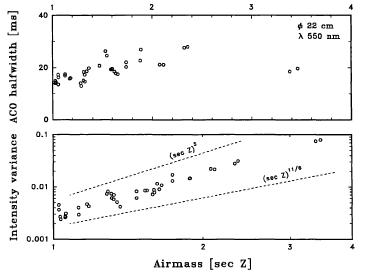



Next: Estimate Of The Isoplanatic
Up: Measurement Technique
Previous: Measurement Technique
Index
Stars near the horizon scintillate with greater amplitude but more slowly than stars near zenith this causes the low-frequency naked-eye twinkling to become prominent near the horizon. This zenith distance dependence has been measured by Bufton and Genatt (1971), Darchiya (1966), Diamant et al.(1969). Although the scintillation increases away from zenith, the increase does not continue until the very horizon. Typically, the amplitude increases until around Z=60 or 70
or 70 , where it saturates (or even decreases). The saturation angle depends on the airmass traversed, and may differ between low and high altitude sites. Only a few studies at extreme zenith distances seem to exist, e.g. Butler (1952) who recorded scintillation at an elevation of only 1
, where it saturates (or even decreases). The saturation angle depends on the airmass traversed, and may differ between low and high altitude sites. Only a few studies at extreme zenith distances seem to exist, e.g. Butler (1952) who recorded scintillation at an elevation of only 1 above the horizon. More subtle effects include the aperture-size dependence for the saturation angle, being closer to zenith for smaller telescope apertures. Further, the validity of a log-normal distribution seems to become weaker with increasing zenith distance.
above the horizon. More subtle effects include the aperture-size dependence for the saturation angle, being closer to zenith for smaller telescope apertures. Further, the validity of a log-normal distribution seems to become weaker with increasing zenith distance.
Figure 5.1:
Scintillation amplitudes and time scales increase with zenith distance. Upper curve for large aperture and down for small aperture. Measured with a 22cm aperture.
|
|
Theories have been developed in the wave-optical treatment by Tatarski (1961), and in the geometrical optics one by Reiger (1963). Although different in other aspects, these agree on the zenith angle dependence,  , for large apertures. The concepts are discussed by Bufton (1973) and Parry et al. (1979). In the case of wave-optics (small apertures) a dependence
, for large apertures. The concepts are discussed by Bufton (1973) and Parry et al. (1979). In the case of wave-optics (small apertures) a dependence
 , and in the geometrical optics case (large apertures)
, and in the geometrical optics case (large apertures)
 . To account for saturation at large zenith angles, Young (1969, 1970a, b) showed how effects of seeing and color dispersion cause deviations from this
. To account for saturation at large zenith angles, Young (1969, 1970a, b) showed how effects of seeing and color dispersion cause deviations from this  dependence, light traversing large airmasses is spread out laterally, thus providing spatial averaging. The zenith distance dependence of the scintillation index
dependence, light traversing large airmasses is spread out laterally, thus providing spatial averaging. The zenith distance dependence of the scintillation index
 can be numerically modeled under certain assumptions. The results show how
can be numerically modeled under certain assumptions. The results show how
 increases until some zenith angle, then saturates and finally decreases near the horizon. Here of course because of the small aperture telescopes used the asumption is
increases until some zenith angle, then saturates and finally decreases near the horizon. Here of course because of the small aperture telescopes used the asumption is
 .
.




Next: Estimate Of The Isoplanatic
Up: Measurement Technique
Previous: Measurement Technique
Index


![]() , for large apertures. The concepts are discussed by Bufton (1973) and Parry et al. (1979). In the case of wave-optics (small apertures) a dependence
, for large apertures. The concepts are discussed by Bufton (1973) and Parry et al. (1979). In the case of wave-optics (small apertures) a dependence
![]() , and in the geometrical optics case (large apertures)
, and in the geometrical optics case (large apertures)
![]() . To account for saturation at large zenith angles, Young (1969, 1970a, b) showed how effects of seeing and color dispersion cause deviations from this
. To account for saturation at large zenith angles, Young (1969, 1970a, b) showed how effects of seeing and color dispersion cause deviations from this ![]() dependence, light traversing large airmasses is spread out laterally, thus providing spatial averaging. The zenith distance dependence of the scintillation index
dependence, light traversing large airmasses is spread out laterally, thus providing spatial averaging. The zenith distance dependence of the scintillation index
![]() can be numerically modeled under certain assumptions. The results show how
can be numerically modeled under certain assumptions. The results show how
![]() increases until some zenith angle, then saturates and finally decreases near the horizon. Here of course because of the small aperture telescopes used the asumption is
increases until some zenith angle, then saturates and finally decreases near the horizon. Here of course because of the small aperture telescopes used the asumption is
![]() .
.